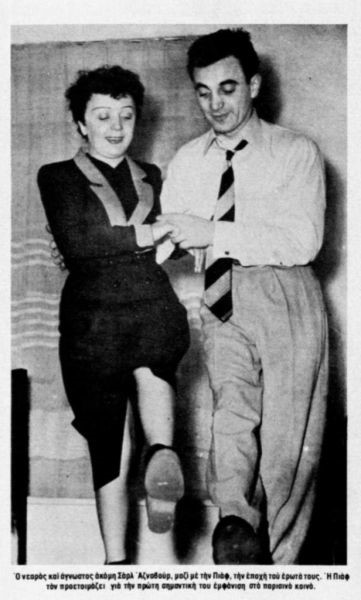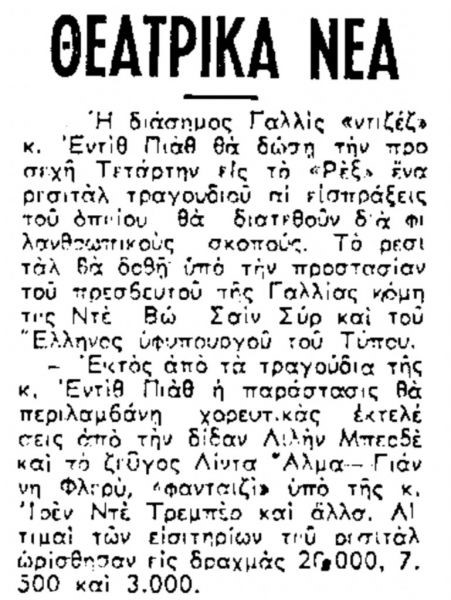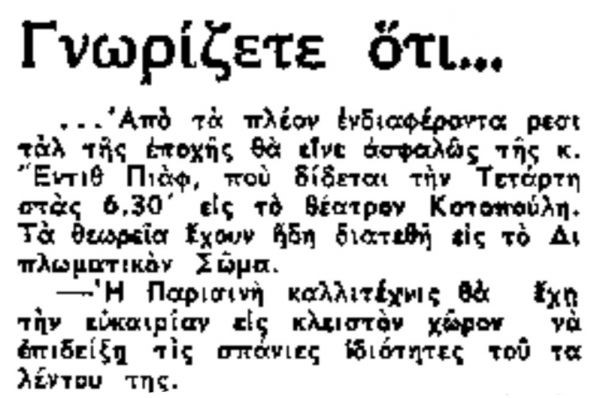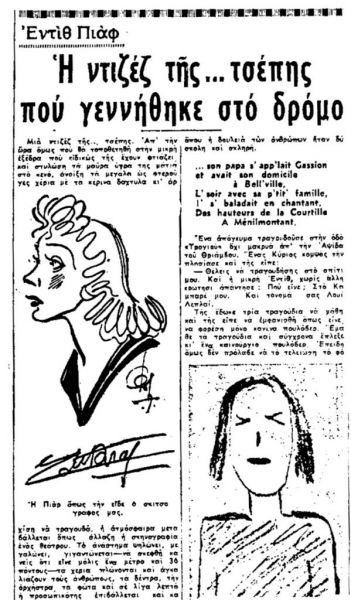On 10 October 1963, one of the world’s greatest singers, the French chanteuse Edith Giovanna Gassion, who became a household name around the world under the stage name Edith Piaf, passed away.
Edith Piaf was born in Paris on 19 December 1915. Her father Louis Alphonse was an acrobatic street performer and her mother Annetta Maillard a singer. Aged seven, she joined her father on his circus tours and at ten she started singing in the street.
And it is with a song delivered on a Parisian street that she enchants the manager of Paris’s most elegant cabaret on the Champs Elysees, who signs her up and advertises her as “la Môme Piaf”: the little sparrow.
Her first album is released in 1935, and during World War II and the German Occupation, she gives concerts for prisoners of war. Gradually, her popularity begins to spread beyond France. When she is popular all over Europe, she starts performing abroad.
A tragic childhood O TACHYDROMOS had this to say about Edith Piaf on 1 September 1956: ‘To those who know nothing of her past, the French songbird may seem unduly melancholy: she is wealthy, counts Jean Cocteau and Marlene Dietrich among her loyal friends, and is adored by her fans… And yet.
‘Edith was just two months old when her mother abandoned her. Then, when her father decided to take charge of her, the Great War began and he had to leave for the Front.
‘So she was brought up by her grandmother, her mother’s mother, “a madame and demi-mondeuse past her prime, with curious habits to boot. She decided, for instance, that dry red wine would toughen the child up quicker than milk.
‘When Edith lost her sight, her other grandmother took over her upbringing. Three years later, little Edith was returned to the light.
‘”Everyone thought it a proper miracle. She grew up in the Belleville district, an ugly little girl with crooked skinny legs, sickly and weak, whose only asset was her expressive little voice.”
A teenage mother
‘Before she turned twelve, her father took her with him to work in a traveling circus. He thought school unnecessary, so his daughter could still not read or write. At 15, she decided to move in with an acrobat her own age.
‘Unhappy souls, creatures from a hell wrought specially for children, Edith and Petit Louis set off alone one day, hand in hand, for Paris. Of course, their age plus hunger and misery would separate them, but a daughter, Marcelle, was born of their union.
‘To support her daughter, Edith, who was still a minor herself, worked in a dairy in the morning and a shoe factory in the afternoon before taking to the streets to sing come evening.
‘But self-denial cannot save a life, and Marcelle would close her eyes forever at the age of two. Even now, Edith wonders how she bore the pain, how despair didn’t drive her to suicide. But without ever forgetting, she kept on living and beat life at its own game.
Her first hit
‘Piaf continued somehow, as did her adventures.
‘Her first hit “Mon Légionnaire” was based on one of these. She met a young boy of twenty-five, fell madly in love with him, but lost him forever two months later without ever learning how or why. On hearing the sad tale, Raymond Asso composed a song called “The Legionnaire” and gave it to Piaf. She read it, thought it failed to capture the full depth of her emotions, and returned it to him. But when she heard it performed by another singer, she leaped to her feet: “Only I can sing it as it should be sung!”
‘So she sang it her way… and it became her first hit.
‘And since then, the sickly but dauntless artiste has ascended step by step, song by song, to the place that is now hers beyond any dispute: at the very pinnacle of the French chanson tradition.’
The French Resistance
As O TACHYDROMOS of 23 July 1981 reports:
‘During the [Second World] War, Piaf is active on multiple fronts. On the one hand, she maintains good relations with the conqueror, dining with the German commandant, singing in the German barracks.
‘But on the other, she hands out money to the Resistance like it’s going out of fashion and, together with her secretary Andrée Bigard, who is a member of that organization, she goes further still: she contrives to be photographed with French prisoners in the camps, then enlarges the photos and makes fake IDs, which she sends to them back in the camps. And these counterfeit papers helped many prisoners to get through the German blockades after their escape.’
With Yves Montand and Charles Aznavour
In 1944, when Piaf is already established in Paris, she discovers Yves Montand, falls for him and thrusts him into the limelight. Theirs will be a short but stormy affair.
As reported in O TACHYDROMOS of December 5, 1969, ‘Edith Piaf would go on to help many more of her colleagues: “This friend of mine,” Piaf writes in her memoirs, “is certainly known to you, and he is to many, because he is one of the greatest singers in the world today. I am talking about Charles Aznavour.”

O TACHYDROMOS, 23.7.1981, TO VIMA & TA NEA Historical Archive
‘Having received an ecstatic reception at one of his first concerts and taken his bow, Aznavour shut himself up in his dressing room and wrote a letter to Piaf.
‘”Edith, after so many years of effort and toil, I have finally made it! But I want you to know that every laurel in the wreath the public has crowned me with, every one without exception, from first to last, I owe to you. So allow me, with gratitude, to present to you my success tonight. It is yours.”’
Piaf in Athens
On September 14, 1946, TA NEA announced the arrival of ‘the famous French diseuse Mme Edith Piaf’ in Athens.

TA NEA, 14.9.1946, TO VIMA & TA NEA Historical Archive
The performances are scheduled for 18 September at the Rex Theater’s Marika Kotopouli stage.

TO VIMA, 15.9.1946, TO VIMA & TA NEA Historical Archive
1946 was also the year she first sang in public the song that would make her a household name around the world: La vie en rose.
‘A pocket-sized diseuse,’ Michalis Kyriakidis writes in TA NEA. ‘But from the moment she is placed on the small platform that has been specially made for her and fixes her black liquid eyes on the void, opens her wing-like arms with their pale white fingers and begins to sing, the atmosphere changes as surely as when the set is changed in the theater.
‘She grows tall, higher and higher until she’s a giant—and to think she’s only four foot five (1.36m) tall! Her hands reach out and embrace the people, the trees, the orchestra, the lights, and within minutes her personality has imposed itself on the room and conquered it.
‘But she does not use her voice to impose herself. No, she employs it as a means of expression, and it triumphs in that role (…) All the emotions a song requires—joy and pain, love hate and misery, are conveyed in an intensely expressive way that is realistic and depressing at one and the same time (…) When she finishes her song, people forget to applaud. For the simple reason that she has set their minds racing.

TA NEA, 16.9.1946, TO VIMA & TA NEA Historical Archive
Spending money like water
Piaf’s global success earned her vast amounts of money during her career, but she squandered it all:
‘I am ashamed,’ she says in her autobiography, ‘when I think of how much good I could have done with the money I simply threw out the window.’
Still, Piaf did often support strangers financially.
‘I was sitting on one of the high stools in front of the bar when I suddenly caught sight of a young woman leaving the bar, almost staggering into the street (…) She took a few more steps, then bent down, placed the bundle [she was carrying] on the doorstep of a house, and walked away. (…) Wrapped up inside was a newborn baby.’
Piaf took the baby in her arms and set off after the young woman at a run. When Piaf caught up with her, the woman explained she was unmarried, that the father of the child had abandoned her and that her parents had thrown her out into the street.
‘Though she was in two minds about coming, she followed me back to the bar. We sat down at a table (…) I opened my bag, took out my check book, signed a check for a million francs and gave it to her.
An ‘encounter’ with Mikis Theodorakis
In 1960, Mikis Theodorakis released the album “Deserters” in which he set four poems by his brother Yannis to music. These included “You will be mine” (Beautiful City).
In 1962, Theodorakis wrote music for Raymond Rouleau’s film Les amants de Teruel. One of the film’s main musical themes was based on the melody from “Beautiful City”, with new French lyrics by Jacques Plante.
Edith Piaf would sing it in one of her last recordings.
Finale
Piaf died aged 48 in 1963.
Her health had been shaken by years of heavy drinking and the medication she took to combat her chronic arthritis and insomnia.
She lived a life of mental and physical pain, awash in alcohol but also filled with glory, love and powerful emotion.


